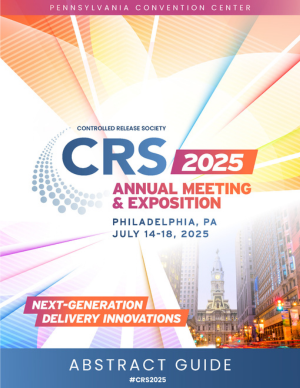Industry Session
Workshop: Diagnostics with Phospholipids - Quality standards and areas of application
Lipid-Shelled Microbubbles and Nanodroplets for Diagnostic and Therapy Applications
Monday, July 14, 2025
3:40 PM - 4:00 PM EDT
Location: 119 A
Sponsored By


The introduction of gas microbubbles (MB) as ultrasound contrast enhancers over three decades ago has revolutionized patient examination methods. MBs significantly enhance ultrasound image contrast by effectively scattering ultrasound waves, which improves the visualization of blood flow and tissue structures. Additionally, they enable real-time imaging, providing immediate feedback that is beneficial for monitoring treatment progress and interventions.
Commercially available Ultrasound Contrast Agents are often administered intravenously and typically consists of polydisperse gas encapsulated microbubbles with diameter ranging between 1 and 10 m and MBs concentration of approx. 108 to 109 MBs/mL Among the numerous coatings used to produce contrast agents, phospholipids are the most widely applied, offering a favorable compromise between MB stability and echogenicity [1]. The first part of the presentation will be dedicated to SonoVue®/Lumason®, Bracco’s contrast agent consisting of sulfur hexafluoride (SF6) gas encapsulated in a lipid layer. Upon reconstitution with a saline solution, a milky gas microbubbles suspension is generated with specific size distribution and concentration.
Furthermore, MB can be engineered to target specific tissues expressing molecular markers, enhancing the ability to diagnose and monitor diseases at a molecular level, an approach known as molecular imaging. Numerous preclinical studies have demonstrated the feasibility of this approach for imaging various disease conditions, such as inflammation and angiogenesis [2-3]. The second part will highlight the clinical development of BR55, an advanced Ultrasound Molecular Imaging agent under development by Bracco. BR55 is a molecularly targeted lipid-shelled microbubble specifically developed for molecular imaging of angiogenesis, thanks to the use of a high affinity targeting peptide.
Due to their large size, MBs are restricted to the vasculature and suffer a short in-vivo lifetime. Perfluorocarbon nanodroplets (NDs) are a new class of agents that have been proposed to overcome these challenges. These sub-micrometric droplets can extravasate from leaky vasculature into interstitial tissues and can be ultimately converted to echogenic gaseous microbubbles via an external ultrasound stimulus [4]. In the last part of the lecture, we will focus on the use of microfluidics as a powerful and scalable technique for the consistent manufacture of controlled lipid-shelled nano and micro- assemblies. These monodisperse sonoresponsive agents are expected to increase imaging sensitivity and improve drug delivery efficiency.
References:
[1] Frinking P. et al. Ultrasound Med Biol. 2020; 46(4); 892-908
[2] Hyvelin J-M, Tardy I, Bettinger T, et al. Ultrasound molecular imaging of transient acute myocardial ischemia with a clinically translatable P- and E-selectin targeted contrast agent: correlation with the expression of selectins. Invest. Radiol 2014;49:224–235.
[3] Wang S, Targeting of microbubbles: contrast agents for ultrasound molecular imaging, J Drug Target. 2018 ; 26(5-6): 420–434
[4] Melich R. et al. Ultrasound Med Biol. 2024: 50(7):1010-1019
Commercially available Ultrasound Contrast Agents are often administered intravenously and typically consists of polydisperse gas encapsulated microbubbles with diameter ranging between 1 and 10 m and MBs concentration of approx. 108 to 109 MBs/mL Among the numerous coatings used to produce contrast agents, phospholipids are the most widely applied, offering a favorable compromise between MB stability and echogenicity [1]. The first part of the presentation will be dedicated to SonoVue®/Lumason®, Bracco’s contrast agent consisting of sulfur hexafluoride (SF6) gas encapsulated in a lipid layer. Upon reconstitution with a saline solution, a milky gas microbubbles suspension is generated with specific size distribution and concentration.
Furthermore, MB can be engineered to target specific tissues expressing molecular markers, enhancing the ability to diagnose and monitor diseases at a molecular level, an approach known as molecular imaging. Numerous preclinical studies have demonstrated the feasibility of this approach for imaging various disease conditions, such as inflammation and angiogenesis [2-3]. The second part will highlight the clinical development of BR55, an advanced Ultrasound Molecular Imaging agent under development by Bracco. BR55 is a molecularly targeted lipid-shelled microbubble specifically developed for molecular imaging of angiogenesis, thanks to the use of a high affinity targeting peptide.
Due to their large size, MBs are restricted to the vasculature and suffer a short in-vivo lifetime. Perfluorocarbon nanodroplets (NDs) are a new class of agents that have been proposed to overcome these challenges. These sub-micrometric droplets can extravasate from leaky vasculature into interstitial tissues and can be ultimately converted to echogenic gaseous microbubbles via an external ultrasound stimulus [4]. In the last part of the lecture, we will focus on the use of microfluidics as a powerful and scalable technique for the consistent manufacture of controlled lipid-shelled nano and micro- assemblies. These monodisperse sonoresponsive agents are expected to increase imaging sensitivity and improve drug delivery efficiency.
References:
[1] Frinking P. et al. Ultrasound Med Biol. 2020; 46(4); 892-908
[2] Hyvelin J-M, Tardy I, Bettinger T, et al. Ultrasound molecular imaging of transient acute myocardial ischemia with a clinically translatable P- and E-selectin targeted contrast agent: correlation with the expression of selectins. Invest. Radiol 2014;49:224–235.
[3] Wang S, Targeting of microbubbles: contrast agents for ultrasound molecular imaging, J Drug Target. 2018 ; 26(5-6): 420–434
[4] Melich R. et al. Ultrasound Med Biol. 2024: 50(7):1010-1019

Samir CHERKAOUI, PhD (he/him/his)
Head of Novel Agents Department
BRACCO Suisse
Plan-les-Ouates, Switzerland

